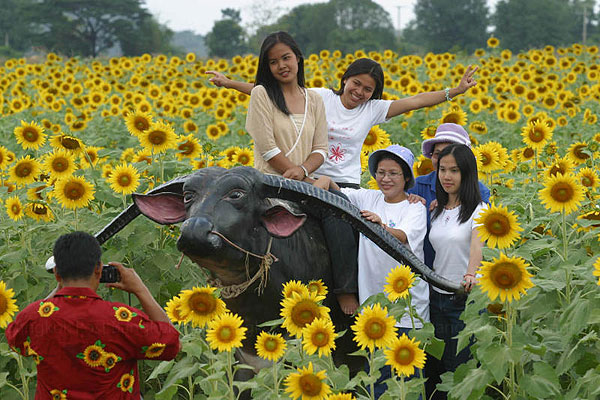SW explores Lop Buri
By Itsarin Tisantia
Photos courtesy of Bangkok Post
Apart from being home to the world’s largest sunflower field, Lop Buri is famous for abundant natural resources and historical archaeological sites.
For Freeze Frame this week, SW explores some of Lop Buri’s top tourist attractions.
 |
Tourists walk past monkey sculptures in central Lop Buri. Monkeys are a symbol of the province. |
 |
Monkeys are treated to an annual fruit banquet in front of the sacred Phra Prang Sam Yot shrine, which is one of Lop Buri’s famous landmarks. |
 |
Visitors who love adventure can go hiking at Mount Chine Lae. |
 |
The world’s largest sunflower field is located in Pattana Nikhom district, where visitors can enjoy beautiful scenic views. |
 |
At the Ban Pong Manao Archaeological Site, remains of ancestors believed to be about 3,000 years old are displayed. |
 |
This HIV sign stands out at Phrabat Namphu Temple. The province’s most famous temple is dedicated to helping people living with HIV. |
 |
King Narai’s Palace was built by King Narai the Great during the Ayutthaya Period, around 800 years ago. |
EXERCISE
Read through Freeze Frame and decide whether the following sentences are true or false.
1. Phrabat Namphu is dedicated to helping HIV patients.
…………………….
2. The world’s largest sunflower field is located in Lop Buri’s Muang district.
…………………….
3. Phra Prang Sam Yot is one of Lop Buri’s famous landmarks.
…………………….
4. Ban Pong Manao Archaeological Site displays the remains of ancestors believed to be about 30,000 years old.
…………………….
Vocabulary
- abundant (adj): existing in large quantities
archaeological (adj): connected with the study of periods of history by examining the remains of buildings and objects found in the ground
banquet (n): a large impressive meal
landmark (n): something, such as a large building, that you can see clearly from a distance


